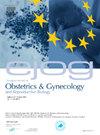Comparative outcomes of interventional embolization and laparoscopic tubal ligation on frozen-thawed embryo transfer success in women with hydrosalpinx
IF 2.1
4区 医学
Q2 OBSTETRICS & GYNECOLOGY
European journal of obstetrics, gynecology, and reproductive biology
Pub Date : 2025-03-20
DOI:10.1016/j.ejogrb.2025.03.046
引用次数: 0
Abstract
Objective
This study aimed to evaluate the comparative effects of interventional embolization and laparoscopic tubal ligation on the success rates of frozen-thawed embryo transfer (FET) in women with hydrosalpinx, along with an analysis of the specific characteristics associated with each surgical technique.
Methods
Individuals experiencing infertility due to bilateral hydrosalpinx-induced tubal obstruction who had prior unsuccessful assisted reproductive technology (ART) attempts at the Reproductive Center of the Second Affiliated Hospital of Zhengzhou University between January 2015 and May 2024 were included in this study. Participants were allocated into four groups: the interventional embolization group (93 cases), where the proximal hydrosalpinx tube was embolized using a micro coil under X-ray guidance; the laparoscopic ligation group (129 cases), which involved laparoscopic proximal tubal ligation with the creation of a distal stoma; the untreated hydrosalpinx group (146 cases); and the control group (186 cases), consisting of women without hydrosalpinx who underwent FET during the same time frame. The study outcomes assessed FET outcomes, length of stay (LOS), effectiveness, and costs associated with the surgical interventions.
Results
Both the average length of procedure (LOP) and LOS in the laparoscopic ligation group were significantly longer than those in the interventional embolization group, with a statistically significant difference (F = 13.092, P < 0.001). Furthermore, the average hospitalization cost was notably higher in the laparoscopic ligation group (21,548 ± 5,321) yuan compared to the interventional embolization group (8,569 ± 627) yuan, with a statistically significant difference (F = 23.633, P < 0.001). Both surgical groups showed significantly higher embryo implantation rates (48.97 %, 59.56 % vs. 29.25 %) and clinical pregnancy rates (58.84 %, 55.81 % vs. 40.41 %) compared to the untreated hydrosalpinx group, with a statistically significant difference (x2 = 38.437, x2 = 10.462, respectively, P < 0.001). However, the difference between the two surgical groups was not statistically significant.
Conclusion
Both interventional embolization and laparoscopic ligation surgeries can improve fertility outcomes in women with hydrosalpinx. Interventional embolization emerged as the more minimally invasive, cost-effective, and efficient surgical option.
求助全文
约1分钟内获得全文
求助全文
来源期刊
CiteScore
4.60
自引率
3.80%
发文量
898
审稿时长
8.3 weeks
期刊介绍:
The European Journal of Obstetrics & Gynecology and Reproductive Biology is the leading general clinical journal covering the continent. It publishes peer reviewed original research articles, as well as a wide range of news, book reviews, biographical, historical and educational articles and a lively correspondence section. Fields covered include obstetrics, prenatal diagnosis, maternal-fetal medicine, perinatology, general gynecology, gynecologic oncology, uro-gynecology, reproductive medicine, infertility, reproductive endocrinology, sexual medicine and reproductive ethics. The European Journal of Obstetrics & Gynecology and Reproductive Biology provides a forum for scientific and clinical professional communication in obstetrics and gynecology throughout Europe and the world.

 求助内容:
求助内容: 应助结果提醒方式:
应助结果提醒方式:


